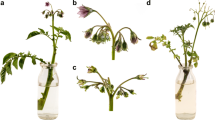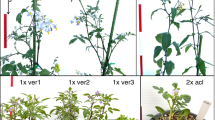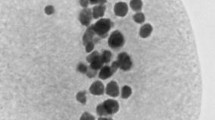Summary
Seventeen potato dihaploids, produced by pollinating the tetraploid (2n = 48) cv ‘Pentland Crown’ with pollen from Solanum phureja (2n = 24) dihaploid inducer clones, were studied. Since dihaploids are thought to develop parthenogenetically from unfertilized ovules they were expected to be euploid (2n = 24), but somatic chromosome counts showed that 15 of the 17 dihaploids were aneusomatic. Ten of the clones were predominantly diploid (2n = 24) with a proportion of hyperploid cells that contained 25 or 26 chromosomes. Five of the dihaploids contained variable numbers of triploid cells (2n = 36). RFLP analysis was used to determine whether the additional chromosomes were from S. phureja or S. tuberosum. Unique hybridizing fragments present in S. phureja but not in ‘Pentland Crown’ were identified. These S. phureja-specific restriction fragments were present in some of the dihaploid offspring of ‘Pentland Crown’. Of the 5 clones that contained triploid cells 4 had S. phureja type banding. Four of the 10 aneusomatic clones that contained hyperploid cells had the unique S. phureja hybridizing fragments. We propose that ovules of ‘Pentland Crown’ were fertilized by pollen from S. phureja and that the aneusomatic clones were derived from triploid zygotes from which some of the S. phureja chromosomes were eliminated. We consider that this is an additional mechanism of dihaploid formation in potato.
Similar content being viewed by others
References
Barclay IR (1975) High frequencies of haploid production in wheat (Triticum aestivum) by chromosome elimination. Nature 256:410–411
Bender K (1963) The production and origin of dihaploid plants in Solanum tuberosum. Z Pflanzenzuech 50:144–166
Bowler C, Alliotte T, DeLoose M, Van Montagu M, Inze D (1989) The induction of manganese superoxide dismutase in response to stress in Nicotiana plumbaginifolia. EMBO J 8:31–38
Caligari PDS, Powell W, Liddell K, De Maine MJ, Swan GEL (1988) Methods and strategies for detecting Solanum tuberosum dihaploids in interspecific crosses with S. phureja. Ann Appl Biol 112:323–328
Chase SE (1963) Analytical breeding of Solanum tuberosum: A scheme utilizing parthenotes and other diploid stocks. Can J Genet Cytol 5: 359–363
Feinberg AP, Vogelstein B (1983) A technique for radiolabelling DNA restriction endonuclease fragments to high specific activity. Anal Biochem 132: 6–13
Hermsen JGTh, Verdenius J (1973) Selection from Solanum tuberosum group Phureja of genotypes combining high-frequency haploid induction with homozygosity for embryospot. Euphytica 22:244–259
Hougas RW, Peloquin SJ (1957) A haploid plant of the potato variety Katahdin. Nature 180:1209–1210
Hougas RW, Peloquin SJ, Gabert AC (1964) Effect of seed parent and pollinator on frequency of haploids in Solanum tuberosum. Crop Sci 4:593–595
Kasha KY (1974) Haploids from somatic cells. In: Kasha KJ (ed) Haploids in higher plants: advances and potential. University of Guelph, Guelph, pp 67–87
Kasha KJ, Kao KN (1970) High frequency of haploid production in Barley (Hordeum vulgare L). Nature 225:874–876
Kao KN, Kasha KJ (1969) Haploids from interspecific crosses with tetraploid barley. Barley Genetics 2:82–87
Lange W (1969) Cytogenetic and embryological studies of crosses between Hordeum vulgare and H. bulbosum. Versl. Landbouwkund. Onderzoek. 719: pp 161.
Laurie DA, Bennett MD (1986) Wheat × maize hybridization. Can J Genet Cytol 28:313–316
Maniatis T, Fritsch EF, Sambrook J (1982) Molecular cloning: a laboratory manual. Cold Spring Harbor Laboratory, Cold Spring Harbor, N.Y.
Montelongo-Escobedo H, Rowe PR (1969) Haploid induction in potato: cytological basis for the pollinator effect. Euphytica 18:116–123
Peloquin SJ, Hougas RW, Gabert AC (1966) Haploidy as a new approach to cytogenetics and breeding of Solanum tuberosum. In: Riley P, Lewis KR (eds) Chromosome manipulations and plant genetics. Oliver and Boyd, Edinburgh, pp 21–28
Pijnacker LP, Ferwerda MA (1984) Giemsa C-banding of potato chromosomes. Can J Genet Cytol 26:415–419
Pijnacker LP, Ferwerda MA, Puite KJ, Schaart JG (1989) Chromosome elimination and mutation in tetraploid somatic hybrids of Solanum tuberosum and Solanum phureja. Plant Cell Rep 8:82–85
Ramanna MS, Hermsen JGTH (1971) Somatic chromosome elimination and meiotic chromosome pairing in the triple hybrid 6 × — (Solanum acaule × S. bulbocastanum) × 2 × — S. phureja. Euphytica 20:470–481
Reed KC, Mann DA (1985) Rapid transfer of DNA from agarose gels to nylon membranes. Nucleic Acids Res 13:7207–7221
Rowe PR (1974) Methods of producing haploids: Parthenogenesis following interspecific hybridization. In: Kasha KJ (ed) Haploids in higher plants: advances and potential. University of Guelph, Guelph, pp 43–52
Saghai-Maroof MA, Soliman KM, Jorgensen RA, Allard RW (1984) Ribosomal DNA spacer length polymorphism in barley: Mendelian inheritance, chromosomal location and population dynamics. Proc Natl Acad Sci USA 81:8014–8018
Subrahmanyam NC, Kasha KJ (1973) Selective chromosomal elimination during haploid formation in barley following interspecific hybridisation. Chromosoma 42:111–125
Van Breukelen EWM, Ramanna MS, Hermsen JGTh (1977) Parthenogenic monohaploid (2n=x=12) from Solanum tuberosum L. and S. verrucosum Schlechtd. and the production of homozygous potato diploids. Euphytica 26: 263–271
Wagenheim K-H v, Peloquin SJ, Hougas RW (1960) Embryological investigations on the formation of haploids in the potato (Solanum tuberosum). Z Vererbungslehre 91:391–399
Author information
Authors and Affiliations
Additional information
Communicated by G. Wenzel
Rights and permissions
About this article
Cite this article
Clulow, S.A., Wilkinson, M.J., Waugh, R. et al. Cytological and molecular observations on Solanum phureja-induced dihaploid potatoes. Theoret. Appl. Genetics 82, 545–551 (1991). https://doi.org/10.1007/BF00226789
Received:
Accepted:
Issue Date:
DOI: https://doi.org/10.1007/BF00226789




